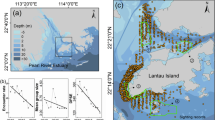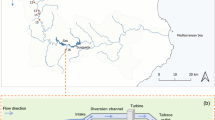Abstract
We examined the scale impacts on spatial hot and cold spots of CPUE for Ommastrephes bartramii in the northwest Pacific Ocean. The original fishery data were tessellated to 18 spatial scales from 5′×5′ to 90′×90′ with a scale interval of 5′ to identify the local clusters. The changes in location, boundaries, and statistics regarding the Getis-Ord Gi* hot and cold spots in response to the spatial scales were analyzed in detail. Several statistics including Min, mean, Max, SD, CV, skewness, kurtosis, first quartile (Q1), median, third quartile (Q3), area and centroid were calculated for spatial hot and cold spots. Scaling impacts were examined for the selected statistics using linear, logarithmic, exponential, power law and polynomial functions. Clear scaling relations were identified for Max, SD and kurtosis for both hot and cold spots. For the remaining statistics, either a difference of scale impacts was found between the two clusters, or no clear scaling relation was identified. Spatial scales coarser than 30′ are not recommended to identify the local spatial patterns of fisheries because the boundary and locations of hot and cold spots at a coarser scale are significantly different from those at the original scale.
Similar content being viewed by others
References
Anselin L. 1995. Local indicators of spatial association-LISA. Geogr Anal, 27(2): 93–115
Anselin L. 2004. Exploring spatial data with GeoDaTM: a workbook. Urbana, USA: University of Illinois, 61801
Arkhipkin A I, Murzov S A. 1986. Age and growth patterns of dosidicus gigas (Ommastrephidae). In: Ivanov B G, ed. Present State of Fishery for Squids and Prospects of Its Development. Moscow: VNIRO Press, 107–123
Carocci F, Bianchi G, Eastwood P, et al. 2009. Geographic Information Systems to Support the Ecosystem Approach to Fisheries: Status, Opportunities and Challenge. Rome, Italy: Food and Agriculture Organization of the United Nations
Chen Xinjun, Chen Yong, Tian Siquan, et al. 2008. An assessment of the west winter–spring cohort of neon flying squid (Ommastre-phes bartramii) in the Northwest Pacific Ocean. Fish Res, 92(2–3): 221–230
Chen C S, Chiu T S. 2003. Variations of life history parameters in two geographical groups of the neon flying squid, Ommastrephes bartramii, from the North Pacific. Fish Res, 63(3): 349–366
Chen Xinjun, Tian Siquan, Guan Wenjian. 2014. Variations of oceanic fronts and their influence on the fishing grounds of Ommastrephes bartramii in the Northwest Pacific. Acta Oceanol Sin, 33(4): 45–54
Ciannelli L, Fauchald P, Chan K S, et al. 2008. Spatial fisheries ecology: Recent progress and future prospects. J Mar Syst, 71(3–4): 223–236
Cope J M, Punt A E. 2011. Reconciling stock assessment and management scales under conditions of spatially varying catch histories. Fish Res, 107(1–3): 22–38
Ebdon D. 1985. Statistics in Geography: A Practical Approach. 2nd ed. London: Wiley-Blackwell
Feng Yongjiu, Chen Xinjun, Liu Yan. 2016. The effects of changing spatial scales on spatial patterns of CPUE for Ommastrephes bartramii in the northwest Pacific Ocean. Fish Res, 183: 1–12
Feng Yongjiu, Chen Xinjun, Liu Yan. 2017a. Detection of spatial hot spots and variation for the neon flying squid Ommastrephes bartramii resources in the northwest Pacific Ocean. Chin J Oceanol Limnol, 35(4): 921–935
Feng Yongjiu, Chen Xinjun, Yang Liu. 2017b. Examining spatiotemporal distribution and CPUE-environment relationships for the jumbo flying squid Dosidicus gigas offshore Peru based on spatial autoregressive model. Chin J Oceanol Limnol: doi: 10.1007/s00343-018-6318-3
Feng Yongjiu, Cui Li, Chen Xinjun, et al. 2017c. A comparative study of spatially clustered distribution of jumbo flying squid (Dosidicus gigas) offshore Peru. J Ocean Univ China, 16(3): 490–500
Feng Yongjiu, Liu Yan. 2015. Fractal dimension as an indicator for quantifying the effects of changing spatial scales on landscape metrics. Ecol Indic, 53: 18–27
Fosså J H, Mortensen P B, Furevik D M. 2002. The deep-water coral Lophelia pertusa in Norwegian waters: distribution and fishery impacts. Hydrobiologia, 471(1–3): 1–12
Gao Feng, Chen Xinjun, Guan Wenjiang, et al. 2016. A new model to forecast fishing ground of Scomber japonicus in the Yellow Sea and East China Sea. Acta Oceanol Sin, 35(4): 74–81
Getis A, Aldstadt J. 2010. Constructing the spatial weights matrix using a local statistic. In: Anselin L, Rey S J, eds. Perspectives on Spatial Data Analysis. Berlin, Heidelberg: Springer, 147–163
Getis A, Ord J K. 1996. Spatial analysis and modeling in a GIS environment. In: McMaster R B, Lynn Usery E, eds. A Research Agenda for Geographic Information Science. Boca Raton: CRC Press, 157–196
Gilly W F, Markaida U, Baxter C H, et al. 2006. Vertical and horizontal migrations by the jumbo squid Dosidicus gigas revealed by electronic tagging. Mar Ecol Prog Ser, 324: 1–17
Gong Caixia, Chen Xinjun, Gao Feng, et al. 2014. Effect of spatial and temporal scales on habitat suitability modeling: A case study of Ommastrephes bartramii in the northwest pacific ocean. J Ocean Univ China, 13(6): 1043–1053
Guinet C, Dubroca L, Lea M A, et al. 2001. Spatial distribution of foraging in female Antarctic fur seals Arctocephalus gazella in relation to oceanographic variables: a scale-dependent approach using geographic information systems. Mar Ecol Prog Ser, 219: 251–264
Gutiérrez N L, Masello A, Uscudun G, et al. 2011. Spatial distribution patterns in biomass and population structure of the deep sea red crab Chaceon notialis in the Southwestern Atlantic Ocean. Fish Res, 110(1): 59–66
Harford W J, Ton C, Babcock E A. 2015. Simulated mark-recovery for spatial assessment of a spiny lobster (Panulirus argus) fishery. Fish Res, 165: 42–53
Huang Jiansheng, Sun Yao, Jia Haibo, et al. 2014. Spatial distribution and reconstruction potential of Japanese anchovy (Engraulis japonicus) based on scale deposition records in recent anaerobic sediment of the Yellow Sea and East China Sea. Acta Oceanol Sin, 33(12): 138–144
Jain A K. 2010. Data clustering: 50 years beyond K-means. Pattern Recogn Lett, 31(8): 651–666
Jennings S, Kaiser M, Reynolds J D. 2009. Marine Fisheries Ecology. New York: John Wiley & Sons
Jiang Tao, Chai Chai, Wang Jifang, et al. 2016. Temporal and spatial variations of abundance of phycocyanin- and phycoerythrinrich Synechococcus in Pearl River Estuary and adjacent coastal area. J Ocean Univ China, 15(5): 897–904
Meaden G J, Aguilar-Manjarrez J. 2013. Advances in Geographic Information Systems and Remote Sensing for Fisheries and Aquaculture. Roma, Italy: Food and Agriculture Organization of the United Nations
Mitchell A. 2005. The ESRI Guide to GIS Analysis, Volume 2: Spatial Measurements and Statistics. Redlands, CA: Esri Press
Mullon C, Fréon P, Cury P. 2005. The dynamics of collapse in world fisheries. Fish Fish, 6(2): 111–120
Nishida T, Chen Dinggeng. 2004. Incorporating spatial autocorrelation into the general linear model with an application to the yellowfin tuna (Thunnus albacares) longline CPUE data. Fish Res, 70(2–3): 265–274
Ord J K, Getis A. 1995. Local spatial autocorrelation statistics: Distributional issues and an application. Geogr Anal, 27(4): 286–306
Paulino C, Segura M, Chacón G. 2016. Spatial variability of jumbo flying squid (Dosidicus gigas) fishery related to remotely sensed SST and chlorophyll-a concentration (2004–2012). Fish Res, 173: 122–127
Peeters A, Zude M, Käthner J, et al. 2015. Getis–Ord’s hot-and coldspot statistics as a basis for multivariate spatial clustering of orchard tree data. Comput Electron Agr, 111: 140–150
Saul S E, Walter III J F, Die D J, et al. 2013. Modeling the spatial distribution of commercially important reef fishes on the West Florida Shelf. Fish Res, 143: 12–20
Su N J, Sun C L, Punt A E, et al. 2008. Environmental and spatial effects on the distribution of blue marlin (Makaira nigricans) as inferred from data for longline fisheries in the Pacific Ocean. Fish Oceanogr, 17(6): 432–445
Swartz W, Sala E, Tracey S, et al. 2010. The spatial expansion and ecological footprint of fisheries (1950 to present). PLoS One, 5(12): e15143
Tian Siquan, Chen Yong, Chen Xinjun, et al. 2010. Impacts of spatial scales of fisheries and environmental data on catch per unit effort standardisation. Mar Freshwater Res, 60(12): 1273–1284
Turner M G, O'Neill R V, Gardner R H, et al. 1989. Effects of changing spatial scale on the analysis of landscape pattern. Landscape Ecol, 3(3–4): 153–162
Wiens J A. 1989. Spatial scaling in ecology. Func Ecol, 3(4): 385–397
Wu Jianguo. 2004. Effects of changing scale on landscape pattern analysis: scaling relations. Landscape Ecol, 19(2): 125–138
Xu Jie, Chen Xinjun, Chen Yong, et al. 2016. The effect of sea surface temperature increase on the potential habitat of Ommastrephes bartramii in the Northwest Pacific Ocean. Acta Oceanol Sin, 35(2): 109–116
Yang Mingxia, Chen Xinjun, Feng Youjiu, et al. 2013. Spatial variability of small and medium scales, resource abundance of Ommastrephes bartramii in Northwest Pacific. Haiyang Xuebao (in Chinese), 33(20): 6427–6435
Yu Wei, Chen Xinjun, Chen Yong, et al. 2015. Effects of environmental variations on the abundance of western winter-spring cohort of neon flying squid (Ommastrephes bartramii) in the Northwest Pacific Ocean. Acta Oceanol Sin, 34(8): 43–51
Yu Wei, Chen Xinjun, Yi Qian, et al. 2016a. Spatio-temporal distributions and habitat hotspots of the winter–spring cohort of neon flying squid Ommastrephes bartramii in relation to oceanographic conditions in the Northwest Pacific Ocean. Fish Res, 175: 103–115
Yu Wei, Yi Qian, Chen Xinjun, et al. 2016b. Modelling the effects of climate variability on habitat suitability of jumbo flying squid, Dosidicus gigas, in the Southeast Pacific Ocean off Peru. ICES J Mar Sci, 73(2): 239–249
Author information
Authors and Affiliations
Corresponding author
Additional information
Foundation item: The National Natural Science Foundation of China under contract No. 41406146; the Open Fund from Laboratory for Marine Fisheries Science and Food Production Processes at Qingdao National Laboratory for Marine Science and Technology of China under contract No. 2017-1A02; Shanghai Universities First-class Disciplines Project-Fisheries (A).
Rights and permissions
About this article
Cite this article
Feng, Y., Chen, X., Gao, F. et al. Impacts of changing scale on Getis-Ord Gi* hotspots of CPUE: a case study of the neon flying squid (Ommastrephes bartramii) in the northwest Pacific Ocean. Acta Oceanol. Sin. 37, 67–76 (2018). https://doi.org/10.1007/s13131-018-1212-6
Received:
Accepted:
Published:
Issue Date:
DOI: https://doi.org/10.1007/s13131-018-1212-6




